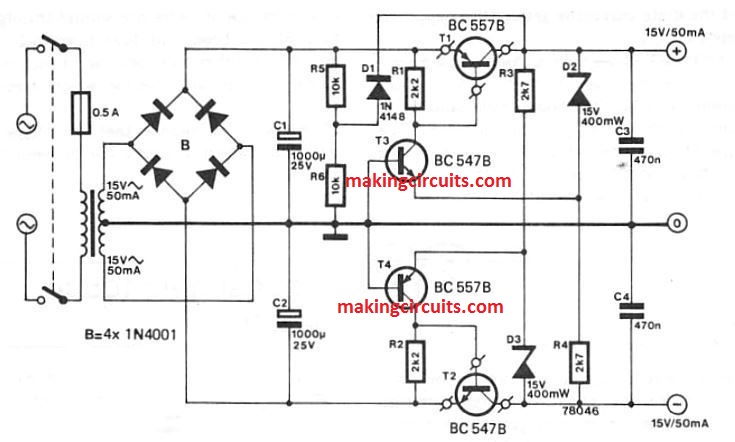In this post we discuss how to build a simple, regulated fixed +/- 15 V symmetrical dual power supply circuit using standard components and very cheaply.
Despite the fact that IC voltage regulators have currently mostly replaced discrete part models, this circuit comes with a significant Cost benefit more than an IC regulator.
Circuit Description
Working of the circuit is incredibly straightforward. The centre-tapped transformer, bridge rectifier and smoothing capacitors C1 and C2 deliver an unregulated supply of around 20 V. The positive and negative regulators work in a similar fashion excluding polarity, therefore just the positive regulator is going to be explained in depth.

The positive supply current moves via a series regulator transistor T1. 15 V is lowered across zener diode D5, the top section being at around +15 V and the bottom end at 0 V. If the output voltage of the regulator happens to drop then the lower terminal of D5 may drop below 0 V and transistor T3 could pull higher current.
This can provide T1 with increased base current, switching it ON excessively in order that the output voltage of the regulator boosts up. When the regulator output voltage gets way too high then the opposite begins happening.
The potential at the D5 bottom terminal rises and T3 pulls lower current. T1 consequently begins deactivating and the source voltage drops.
The negative supply works in the same way. Considering that D5 and D6 obtain their bias through the supply output, R5 , R6 and D7 should be incorporated to enable the circuit to be self-starting.
A preliminary bias of about 10 V through the unregulated supply is supplied by all these parts. As soon as the supply output voltage rises to its typical value D7 gets reverse-biased, which inhibits ripple from the unregulated supply showing up around the output.
The indicated transistors for the +/- 15 V dual power supply circuit will allow only up to 100 mA current. For getting higher current you can simply change the upper and lower series pass transistor with TIP127 and TIP122 respectively or other similar variant, which will provide as high as 3 amp current output
Hello,
I came across your interesting circuit sometime back where you have even showed us how to increase the power output of this circuit by using TIP122&127 but I wanted to get plus minus 24 volts at higher current using the above mentioned TIP122&127. So how should I go about it please advise, thank you.
Thank you very much, you can increase current by replacing the T1 with TIP127 and T2 with TIP122 to get 1 amp output.
You can replace the 15 V zener diodes with 24V zener diodes to get +/- 24V output
The T3 must be replaced with BC546 and T4 with BC556